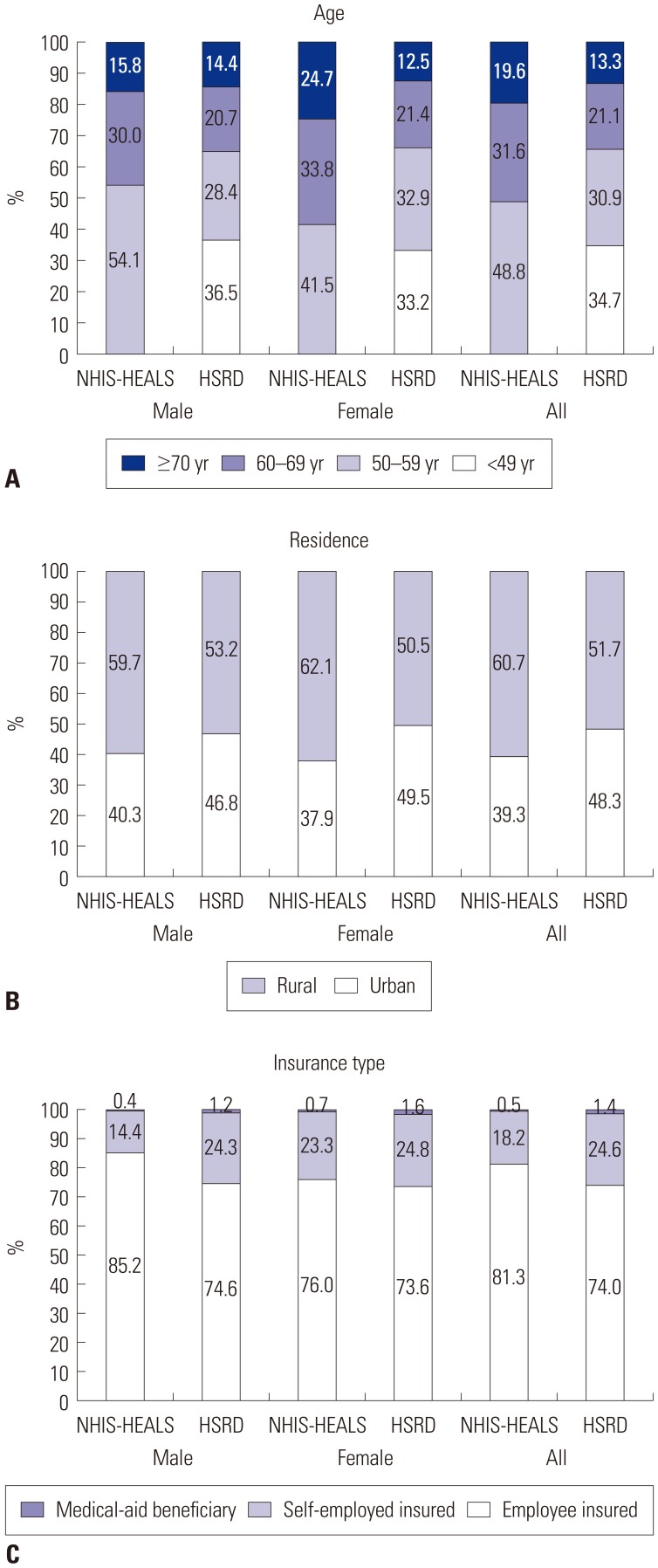Yonsei Med J.
2019 Dec;60(12):1216-1222. 10.3349/ymj.2019.60.12.1216.
The Multi-Institutional Health Screening Records Database of South Korea: Description and Evaluation of Its Characteristics
- Affiliations
-
- 1School of Pharmacy, Sungkyunkwan University, Suwon, Korea. shin.jy@skku.edu
- 2IT Development & Support Office, Seoul, Korea.
- 3Health Promotion Research Institute, Korea Association of Health Promotion, Seoul, Korea. cellonah@hanmail.net
- KMID: 2463802
- DOI: http://doi.org/10.3349/ymj.2019.60.12.1216
Abstract
- This study sought to describe and to evaluate the characteristics of the Health Screening Records Database (HSRD) of the Korea Association of Health Promotion as a data source for epidemiologic studies. The HSRD was compared to a National Health Insurance Service-Health Screening Cohort (NHIS-HEALS) database for 2015. Common variables between the databases were selected, and sex-based analyses were conducted. The HSRD showed statistical concordance when NHIS-HEALS estimates fell within the HSRD estimate's 95% confidence interval. The HSRD and NHIS-HEALS included 946461 and 111690 participants in health screening programs, respectively. Compared to the NHIS-HEALS, the HSRD had more female (55.2% vs. 42.6%) but fewer older adult participants (34.4% vs. 51.2%). Virtually all variables had clinical concordance, with some having statistical concordance as well, among both general and life-transition program participants. The HSRD comprised more clinical information over a wider age range in contrast to the NHIS-HEALS, while showing clinical concordance. Providing more comprehensive clinical data, the HSRD may serve as an alternative resource for epidemiologic studies.
Keyword
MeSH Terms
Figure
Reference
-
1. Korea Association of Health Promotion. Introduction of the Korea Association of Health Promotion [Internet]. Seoul: Korea Association of Health Promotion;c2011. accessed on 2019 July 5. Available at: http://english.kahp.or.kr/cms/doc.php?tkind=90&lkind=66.2. March S. Individual data linkage of survey data with claims data in Germany-an overview based on a cohort study. Int J Environ Res Public Health. 2017; 14:E1543. PMID: 29232834.
Article3. Jang S, Lee J. Prevalence and management of dyslipidemia, hypertension, diabetes among adults in Gangwon-do, Korea: the 2013-2014 KNHSP. Journal of the Korea Academia-Industrial Cooperation Society. 2017; 18:625–636.
Article4. Lee YJ, Kang JW, Kim JY, Na EH, Kim YR, Ko KS, et al. Clustering of health risk behaviors for chronic diseases in Korean adults. Korean J Health Educ Promot. 2017; 34:21–31.
Article5. Nah EH, Cho S, Kim S, Cho HI, Chai JY. Comparison of traditional and reverse syphilis screening algorithms in medical health checkups. Ann Lab Med. 2017; 37:511–515. PMID: 28840989.
Article6. Seong SC, Kim YY, Park SK, Khang YH, Kim HC, Park JH, et al. Cohort profile: the National Health Insurance Service-National Health Screening Cohort (NHIS-HEALS) in Korea. BMJ Open. 2017; 7:e016640.
Article7. Ooba N, Setoguchi S, Sato T, Kubota K. Lipid-lowering drugs and risk of new-onset diabetes: a cohort study using Japanese healthcare data linked to clinical data for health screening. BMJ Open. 2017; 7:e015935.
Article8. Gu D, Xu P, Yuan Y, Fu H. Albuminuria is suggested as a potential health screening biomarker for senior citizens and general population with hypertension or diabetes in China. Clin Lab. 2016; 62:2267–2269. PMID: 28164667.
Article9. Song JU, Hwang J, Ahn JK. Serum uric acid is positively associated with pulmonary function in Korean health screening examinees. Mod Rheumatol. 2017; 27:1057–1065. PMID: 28693364.
Article10. Matsuki N, Fujita T, Watanabe N, Sugahara A, Watanabe A, Ishida T, et al. Lifestyle factors associated with gastroesophageal reflux disease in the Japanese population. J Gastroenterol. 2013; 48:340–349. PMID: 22911169.
Article11. Uematsu H, Yamashita K, Kunisawa S, Otsubo T, Imanaka Y. Prediction of pneumonia hospitalization in adults using health check-up data. PLoS One. 2017; 12:e0180159. PMID: 28662167.
Article12. Austin PC, Stuart EA. Moving towards best practice when using inverse probability of treatment weighting (IPTW) using the propensity score to estimate causal treatment effects in observational studies. Stat Med. 2015; 34:3661–3679. PMID: 26238958.
Article
- Full Text Links
- Actions
-
Cited
- CITED
-
- Close
- Share
- Similar articles
-
- Corrigenda: Omission of the Description on the Approval of Institutional Review Board and the Description on Ethical Treatment of Experimental Animals
- Three New Records of Lichen Genus Rhizocarpon from South Korea
- Two New Records of the Lichen Genus Placynthiella Elenkin in South Korea
- Integrated database-based Screening Cohort for Asian Nomadic descendants in China (Scan-China): Insights on prospective ethnicity-focused cancer screening
- Standardizing the job description of public health dentists in South Korea


